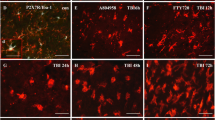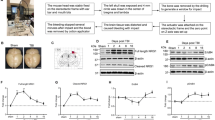Abstract
Degenerative changes in areas remote from the primary lesion site have been linked to the clinical outcome of focal brain damage, and inflammatory mechanisms have been considered to play a key role in the pathogenesis of these remote cell death phenomena. Minocycline is a tetracycline derivative, therapeutically effective in various experimental models of central nervous system (CNS) injuries that include inflammatory and apoptotic mechanisms, although recent findings have yielded mixed results. In this study, we investigated the effectiveness of minocycline treatment in reducing remote cell death. Glial activation and neuronal loss in precerebellar stations following cerebellar lesion were investigated using immunohistochemistry and Western blot techniques. Our results show that minocycline was effective in reducing microglial activations in axotomized precerebellar nuclei, but failed to mitigate either astrocytic response or neuronal loss. This finding supports the role of minocycline in modulating inflammatory response after CNS lesion and suggests its ineffectiveness in influencing degenerative phenomena in areas remote from the primary lesion site.


Similar content being viewed by others
References
Block F, Dihne M, Loos M (2005) Inflammation in areas of remote changes following focal brain lesion. Prog Neurobiol 75:342–365
Block ML, Zecca L, Hong JS (2007) Microglia-mediated neurotoxicity: uncovering the molecular mechanisms. Nat Rev Neurosci 8:57–69
Streit WJ (2002) Microglia as neuroprotective, immunocompetent cells of the CNS. Glia 40:133–139
Ladeby R, Wirenfeldt M, Garcia-Ovejero D, Fenger C, Dissing-Olesen L, Dalmau I et al (2005) Microglial cell population dynamics in the injured adult central nervous system. Brain Res Brain Res Rev 48:196–206
Yrjanheikki J, Keinanen R, Pellikka M, Hokfelt T, Koistinaho J (1998) Tetracyclines inhibit microglial activation and are neuroprotective in global brain ischemia. Proc Natl Acad Sci U S A 95:15769–15774
Festoff BW, Ameenuddin S, Arnold PM, Wong A, Santacruz KS, Citron BA (2006) Minocycline neuroprotects, reduces microgliosis, and inhibits caspase protease expression early after spinal cord injury. J Neurochem 97:1314–1326
Cho KO, Kim SK, Cho YJ, Sung KW, Kim SY (2007) Regional differences in the neuroprotective effect of minocycline in a mouse model of global forebrain ischemia. Life Sci 80:2030–2035
Lampl Y, Boaz M, Gilad R, Lorberboym M, Dabby R, Rapoport A et al (2007) Minocycline treatment in acute stroke: an open-label, evaluator-blinded study. Neurology 69:1404–1410
Diguet E, Fernagut PO, Wei X, Du Y, Rouland R, Gross C et al (2004) Deleterious effects of minocycline in animal models of Parkinson’s disease and Huntington’s disease. Eur J Neurosci 19:3266–3276
Sriram K, Miller DB, O’Callaghan JP (2006) Minocycline attenuates microglial activation but fails to mitigate striatal dopaminergic neurotoxicity: role of tumor necrosis factor-alpha. J Neurochem 96:706–718
Diguet E, Gross CE, Tison F, Bezard E (2004) Rise and fall of minocycline in neuroprotection: need to promote publication of negative results. Exp Neurol 189:1–4
Baptiste DC, Powell KJ, Jollimore CA, Hamilton C, LeVatte TL, Archibald ML et al (2005) Effects of minocycline and tetracycline on retinal ganglion cell survival after axotomy. Neuroscience 134:575–582
Viscomi MT, Florenzano F, Conversi D, Bernardi G, Molinari M (2004) Axotomy dependent purinergic and nitrergic co-expression. Neuroscience 123:393–404
Ryu JK, Choi HB, McLarnon JG (2006) Combined minocycline plus pyruvate treatment enhances effects of each agent to inhibit inflammation, oxidative damage, and neuronal loss in an excitotoxic animal model of Huntington’s disease. Neuroscience 141:1835–1848
Bye N, Habgood MD, Callaway JK, Malakooti N, Potter A, Kossmann T et al (2007) Transient neuroprotection by minocycline following traumatic brain injury is associated with attenuated microglial activation but no changes in cell apoptosis or neutrophil infiltration. Exp Neurol 204:220–233
Acknowledgments
This work was supported by grants from MIUR and the Italian Ministry of Health to MM and to GB. English professional style editing by Claire Montagna is gratefully acknowledged.
Author information
Authors and Affiliations
Corresponding author
Rights and permissions
About this article
Cite this article
Viscomi, M.T., Latini, L., Florenzano, F. et al. Minocycline Attenuates Microglial Activation but Fails to Mitigate Degeneration in Inferior Olive and Pontine Nuclei After Focal Cerebellar Lesion. Cerebellum 7, 401–405 (2008). https://doi.org/10.1007/s12311-008-0042-z
Published:
Issue Date:
DOI: https://doi.org/10.1007/s12311-008-0042-z




